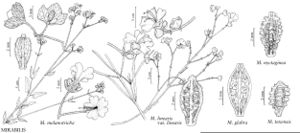Mirabilis nyctaginea
Metasp. Minnesota Valley, 217. 1892.
Stems usually erect or ascending, occasionally decumbent, leafy mostly in proximal 2/3 of plant, openly forked distally, 4–15 dm, basally usually glabrous or puberulent in 2 lines, rarely spreading-pubescent; distally stems usually puberulent in 2 lines, occasionally glabrate, rarely spreading glandular-pubescent. Leaves ascending at 45–80°, abruptly reduced to inflorescence; petiole 0.2–2 cm; blade green, ovate-lanceolate to ovate or triangular, 3–10 × 2–6.5 cm, usually ± thin, base obtuse, round, truncate, or cordate, apex acute to acuminate, rarely rounded, surfaces usually glabrous, sometimes puberulent or sparsely hispidulous. Inflorescences terminal and in upper axils, subumbellate clusters at ends of long, forked branches; peduncle 5–20 mm, usually pubescent with ascending, often curved, glandular or eglandular hairs, crosswalls of hairs pale; involucres pale green, often tinged pinkish, widely bell-shaped to almost rotate, 4–6 mm in flower, 8–15 mm in fruit, glabrous or glabrate but with minute curved hairs on margins, or rarely puberulent or pilose throughout, 50–90% connate, lobes ovate to broadly ovate. Flowers (2–)3(–5) per involucre; perianth usually pink to reddish purple, rarely white, 1 cm. Fruits dark grayish brown to reddish brown (ribs and tubercles usually slightly paler), narrowly obovate and tapering at both ends, 3.4–5 mm, shaggy-pubescent with spreading, sometimes tufted, hairs, 0.3–0.4 mm, sometimes also with layer of minute hairs; ribs usually irregularly and deeply notched, especially toward apex, round to bluntly angled, 0.5–0.75 times width of sulci, 0.5–1 times as wide as high; sulci with pale small to tall tubercles that are sometimes horizontally lengthened and shelflike. 2n = 58.
Phenology: Flowering late spring–early fall.
Habitat: Weedy areas in dry, often disturbed sites
Elevation: 100-2200 m
Distribution
Alta., B.C., Man., Ont., Que., Sask., Ala., Ariz., Ark., Calif., Colo., Conn., D.C., Del., Idaho, Ill., Ind., Iowa, Kans., Ky., La., Maine, Md., Mass., Mich., Minn., Mo., Mont., Nebr., Nev., N.H., N.J., N.Mex., N.Y., N.C., N.Dak., Ohio, Okla., Oreg., Pa., R.I., S.Dak., Tenn., Tex., Utah, Vt., Va., Wash., W.Va., Wis., Wyo., introduced in Mexico, Europe.
Discussion
Mirabilis nyctaginea is considered a noxious weed in some states. The holotype of Mirabilis ×collina Shinners is a hybrid between M. nyctaginea and M. albida. On the Great Plains, M. nyctaginea also appears to intergrade with M. albida. Prominence of the tubercles and redness of the fruits decreases in western populations. Near the Great Lakes, comparatively narrow-leaved plants with sparsely hirsute stems seem to be intergrades between M. nyctaginea and more or less hirsute M. albida. Mirabilis ×serotina Shinners is a hybrid between M. nyctaginea and M. glabra.
Selected References
None.
